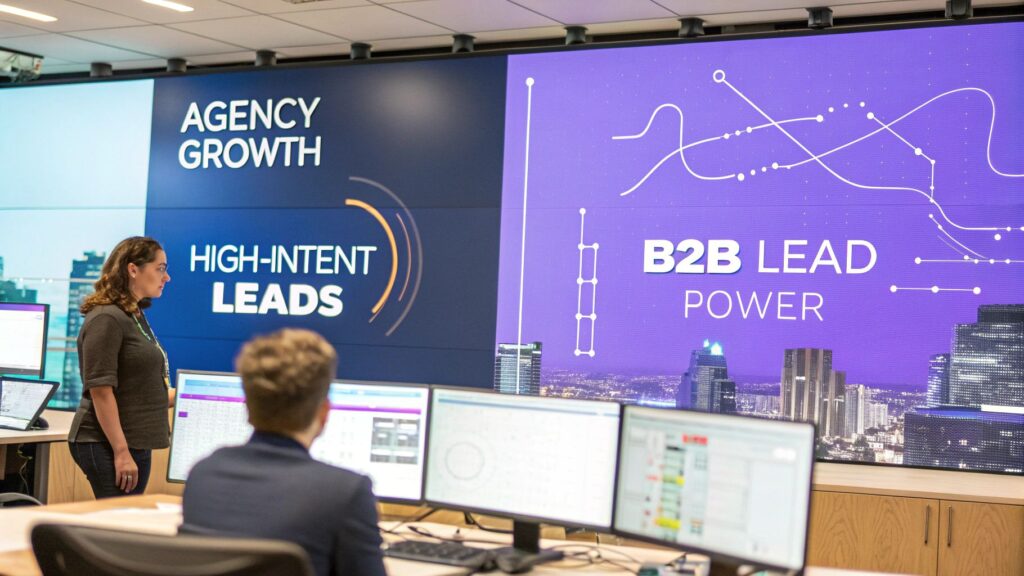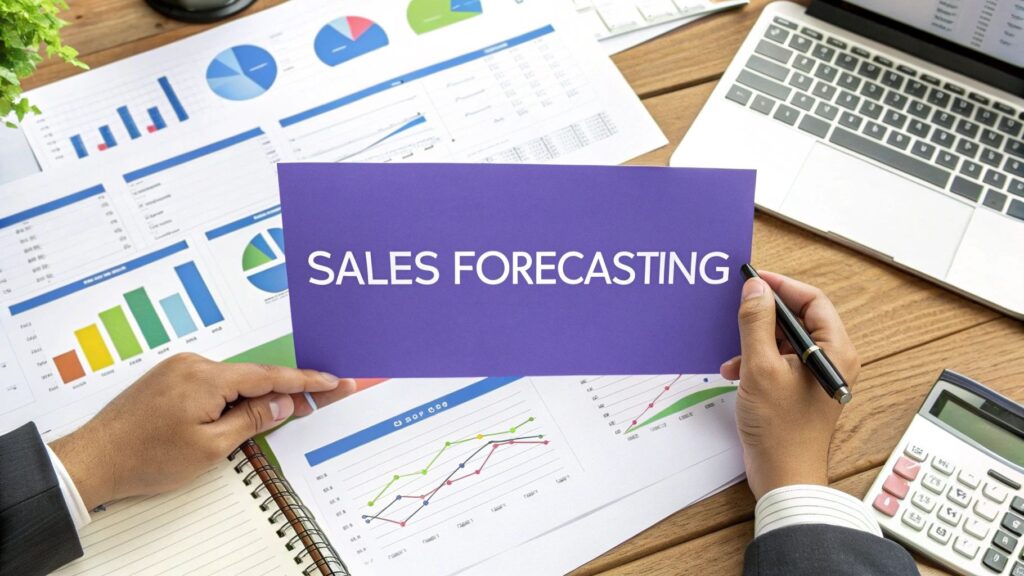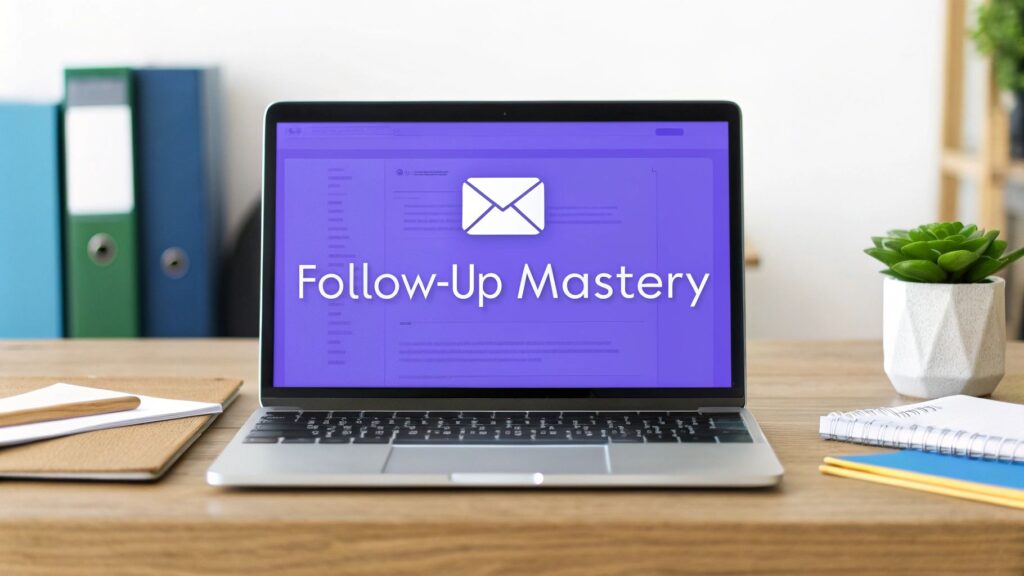Top Marketing Automation Workflow Examples for 2025
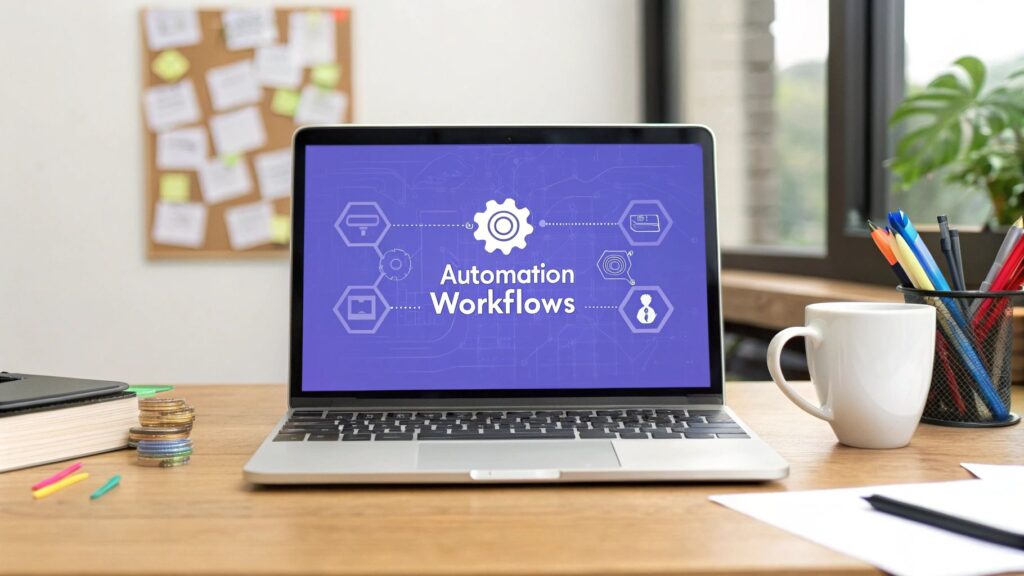
- 1. Welcome Email Series Workflow
- 2. Abandoned Cart Recovery Workflow
- 3. Lead Nurturing Drip Campaign
- 4. Re-engagement/Win-back Workflow
- 5. Post-Purchase Follow-up Workflow
- 6. Webinar/Event Marketing Workflow
- 7. Birthday/Anniversary Workflow
- 8. Lead Magnet Delivery and Indoctrination Workflow
- Marketing Automation Workflow Comparison Table
- From Examples to Execution: Your Next Steps in Automation
Welcome to the definitive guide on marketing automation. In an era where personalization and efficiency are paramount, mastering automation is no longer optional—it's a critical driver of growth. This article moves beyond buzzwords to provide a deep, strategic breakdown of eight essential marketing automation workflow examples you can implement immediately.
You will discover the 'why' behind each workflow, see how top brands execute them, and get actionable steps to replicate their success. This guide is packed with factual data, like how welcome emails can boost revenue by 320% more per email than other promotional emails, and practical insights to help you convert leads, nurture customers, and scale your operations. We will cover everything from initial contact with a Welcome Email Series to reviving dormant customers with a Re-engagement Campaign.
Each example is structured for clarity, offering a behind-the-scenes look at the strategy and specific tactics that make it effective. These automated sequences do more than just send messages; they build relationships. For many businesses, the customer journey is managed within a central hub. Beyond general automation, Mastering CRM Workflow Automation is key to transforming those relationships and driving significant business growth. Prepare to transform your marketing from a series of manual tasks into a smart, self-optimizing engine that works for you 24/7.
1. Welcome Email Series Workflow
A welcome email series is one of the most powerful marketing automation workflow examples your business can implement. It’s an automated sequence of emails sent to new subscribers or customers immediately after they join your list or make a purchase. Instead of a single, generic welcome message, this workflow nurtures the new relationship over several days, introducing the brand, setting expectations, and guiding the user toward a specific action.
The impact is significant; according to data from Invesp, welcome emails can generate 320% more revenue per email than other promotional messages. This is because they arrive when subscriber engagement is at its peak—with open rates averaging over 50%. The user has just taken an action and is actively interested in your brand, making it a critical window to make a strong first impression. Companies like Airbnb and Grammarly excel at this. Airbnb's series teaches new users platform navigation, while Grammarly’s workflow blends tutorials with feature highlights and upgrade prompts over two weeks.
Why It's a Foundational Workflow
A welcome series serves multiple strategic purposes. It confirms the subscription, delivers any promised lead magnet, and establishes your brand's voice. Most importantly, it trains new subscribers to anticipate and open your emails, a crucial step for long-term engagement. To learn how to make these first emails count, you can explore strategies on how to increase email open rates. This initial positive interaction builds trust and credibility right from the start.
This infographic outlines a common three-step process for structuring a welcome email sequence.
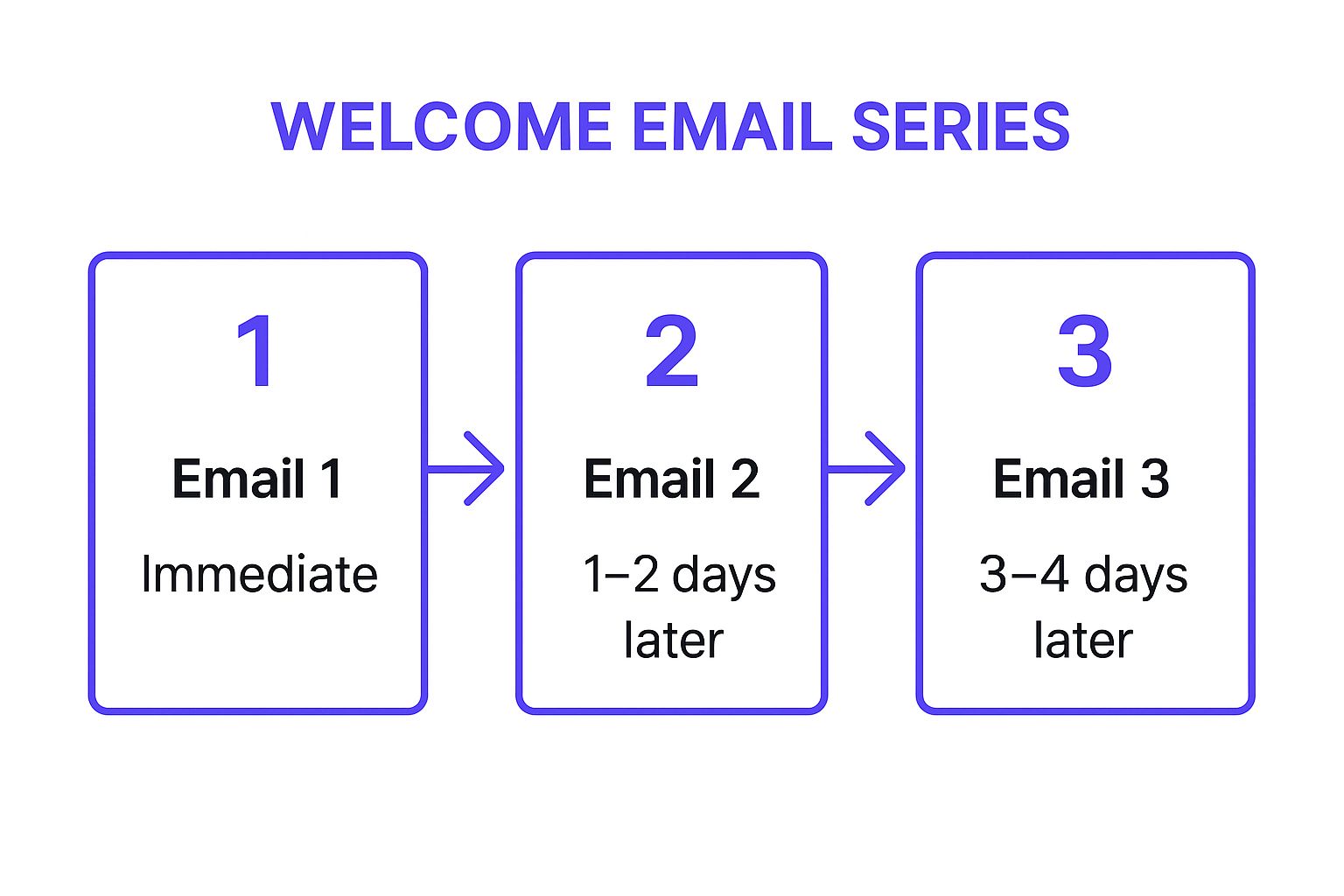
The flow illustrates how spacing out communication helps nurture the relationship without overwhelming the new contact.
Actionable Takeaways
To build an effective welcome series, follow these key steps:
- Act Immediately: Send the first email within minutes of signup. This immediate reinforcement capitalizes on the user's high intent.
- Prioritize Value: Front-load your series with value-driven content like tutorials, tips, or exclusive insights before introducing a hard sales pitch.
- Segment Your Audience: Tailor the welcome journey based on the signup source. A user who downloaded an ebook has different needs than one who signed up from a product page.
- Include Social Proof: Weave in testimonials, user-generated content, or case studies to build credibility and trust early on.
2. Abandoned Cart Recovery Workflow
An abandoned cart workflow automatically targets shoppers who add items to their online cart but leave without completing the purchase. This automated sequence sends a series of reminders designed to bring potential customers back to the store. Considering the average cart abandonment rate hovers around 70%, this workflow represents one of the most direct and high-impact marketing automation workflow examples for e-commerce, capable of recovering 10-30% of otherwise lost sales.
The strategy’s power lies in its timing and relevance. It reconnects with users who have shown high purchase intent at the most critical moment. Brands like Amazon pioneered this by sending timely reminders about price changes or stock availability. Modern e-commerce companies have refined the approach; Chubbies Shorts uses humor with subject lines like “You forgot something… your pants,” while Brooklinen incorporates social proof by adding customer reviews and free shipping reminders into their recovery sequence.
Why It's a High-ROI Workflow
This workflow directly targets revenue that is just one click away from being captured. It addresses common obstacles like shipping costs, technical issues, or simple distractions that interrupt the buying process. By re-engaging these warm leads, you not only recover immediate sales but also gain valuable insights into potential friction points in your checkout experience. For a deeper dive into optimizing your online store, consider exploring insights on e-commerce SEO strategies.
Actionable Takeaways
To build a high-converting abandoned cart workflow, focus on these tactical steps:
- Act Quickly: Send the first reminder email within one hour of abandonment. The user's intent is still fresh, making this the most effective window for recovery.
- Structure a Sequence: Implement a 3-part series: an initial reminder (1 hour), a follow-up addressing common concerns (24 hours), and a final offer with an incentive (72 hours).
- Show, Don't Just Tell: Include high-quality images of the products left in the cart along with a clear call-to-action button to complete the purchase.
- Reserve Discounts Strategically: Offer a discount or free shipping only in the final email. Offering it too early can train customers to abandon carts intentionally to get a better deal.
3. Lead Nurturing Drip Campaign
A lead nurturing drip campaign is a strategic, automated workflow that delivers a series of targeted messages to prospects over time. It is designed to move them through the sales funnel from awareness to consideration and, ultimately, to a decision. Unlike one-time blasts, drip campaigns provide relevant content based on the lead's behavior, interests, and stage in the buyer's journey.
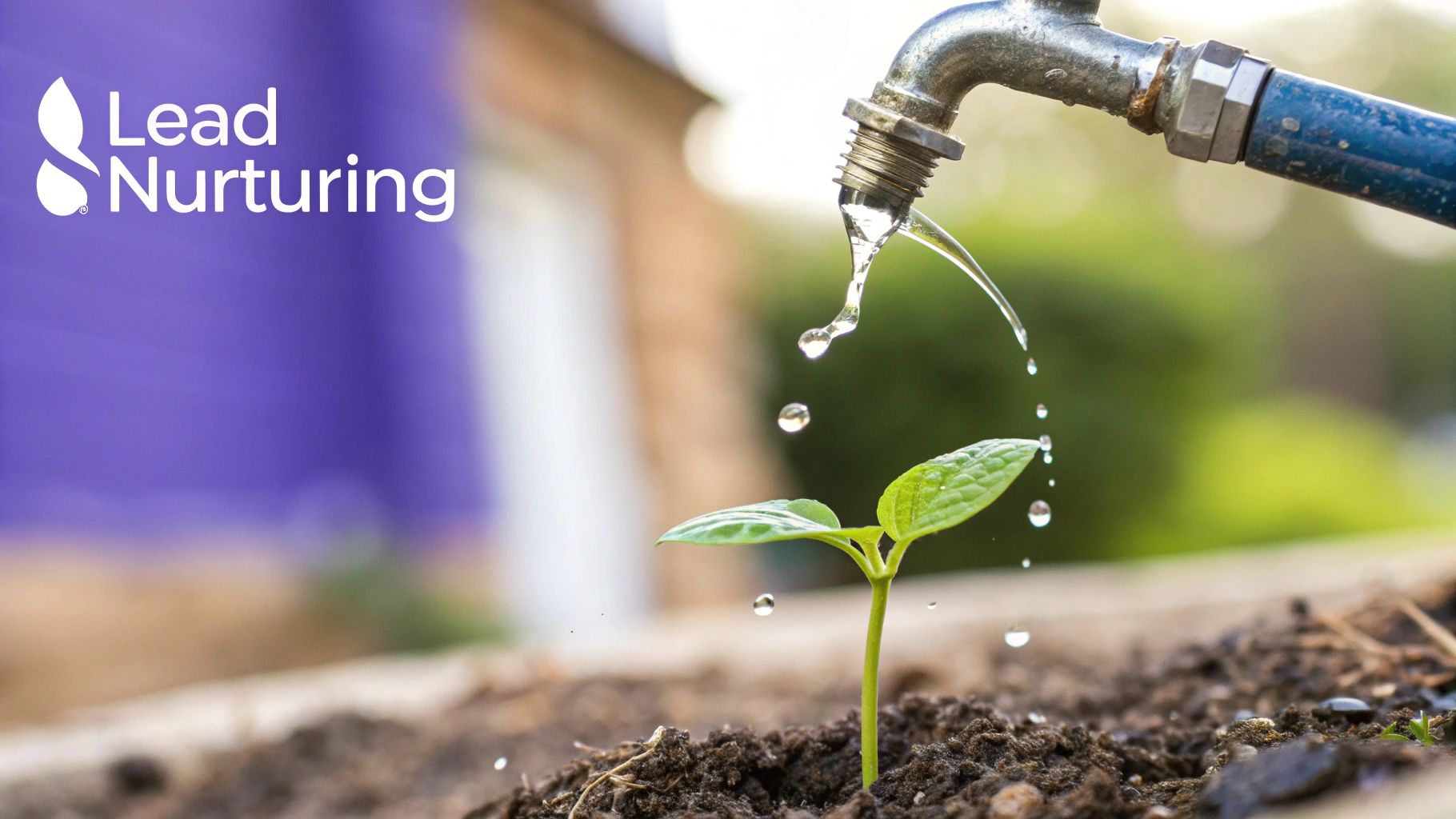
This workflow is essential for B2B and high-value B2C sales because it systematically builds trust and educates prospects. According to Forrester Research, companies that excel at lead nurturing generate 50% more sales-ready leads at a 33% lower cost. For example, HubSpot nurtures leads with educational content based on their industry and role, while Salesforce uses role-based campaigns delivering different assets to executives versus practitioners. LinkedIn leverages content consumption patterns to serve increasingly relevant articles and course recommendations, keeping users engaged.
Why It's a Foundational Workflow
A lead nurturing campaign ensures that no potential customer falls through the cracks. It automates the crucial middle-of-the-funnel engagement, keeping your brand top-of-mind while building authority and trust. By delivering the right information at the right time, you address a prospect’s questions and objections before they even have to ask. To understand the intricacies of this process, you can explore this guide on what lead nurturing is. This consistent, value-driven communication is what transforms a cold lead into a qualified opportunity ready for sales.
Actionable Takeaways
To build an effective lead nurturing drip campaign, follow these key steps:
- Segment Your Leads: Group leads by industry, role, company size, and on-site behavior. Personalization starts with understanding who you're talking to.
- Map Content to the Funnel: Align your content with the buyer's journey. Use informational blog posts for the awareness stage, case studies for consideration, and demos for the decision stage.
- Use Lead Scoring: Implement a scoring system to track engagement. A lead who downloads a whitepaper and visits your pricing page is more qualified than someone who only opened one email.
- Balance Your Content Mix: Follow the 80/20 rule. Eighty percent of your content should be educational and value-driven, while only 20% should be promotional.
- Align with Sales: Ensure marketing and sales agree on the criteria for a "sales-qualified lead" (SQL). This alignment prevents premature handoffs and ensures a smooth customer experience.
4. Re-engagement/Win-back Workflow
A re-engagement or win-back workflow is an essential marketing automation example designed to reactivate subscribers or customers who have become dormant. This automated email sequence targets contacts who haven't opened, clicked, or purchased for a predefined period. Its goal is to reignite their interest, remind them of your brand's value, and bring them back into the fold before they are lost for good.
The financial incentive is powerful; acquiring a new customer can cost five times more than retaining an existing one. A well-executed win-back campaign can successfully re-engage a significant portion of a dormant list, boosting customer lifetime value and improving overall list health. For example, Duolingo masterfully uses its mascot to send playful guilt-trip reminders about losing a learning streak, while Dropbox sends "We miss you" emails highlighting new features added since a user's last login, creating a compelling reason to return.
Why It's a Foundational Workflow
A re-engagement workflow is critical for maintaining a healthy and profitable contact list. It directly addresses customer churn and list decay, which are natural but costly parts of the business lifecycle. By systematically identifying and targeting inactive users, you can prevent list bloat, which improves your sender reputation and email deliverability. More importantly, it gives you a final, structured opportunity to retain a customer you’ve already invested in acquiring.
This proactive approach demonstrates that you value the relationship, often using a special incentive to show appreciation. It can also serve as a valuable feedback mechanism to understand why customers disengage in the first place, providing insights to improve your overall marketing strategy.
Actionable Takeaways
To build an effective re-engagement series, follow these key steps:
- Define Inactivity Clearly: Establish a specific trigger, such as 90 days with no email opens, clicks, or website logins. This ensures the workflow targets the right audience at the right time.
- Lead with an Irresistible Offer: Present a compelling, exclusive incentive to come back. Blue Apron, for instance, offers former subscribers a significant discount like 50% off to make re-subscribing an easy decision.
- Remind Them of Your Value: Focus on what they're missing. Highlight new features, popular products, or positive experiences they once had. Spotify's "Your Year in Music" is a prime example, using personalized data to evoke nostalgia and pull users back.
- Provide a Clean Exit: Make it easy to unsubscribe. A clean list of engaged contacts is more valuable than a large, inactive one. Conclude the series by letting users know you'll be removing them unless they opt to stay.
5. Post-Purchase Follow-up Workflow
A post-purchase follow-up is an automated sequence of communications sent to a customer after they complete a transaction. Instead of treating the sale as the end of the customer journey, this workflow transforms it into the beginning of a long-term relationship. It aims to boost customer satisfaction, solicit valuable feedback, provide product education, and ultimately drive repeat business.
This workflow is critical because retaining an existing customer is five times cheaper than acquiring a new one. Post-purchase automation capitalizes on the post-sale "honeymoon period" when customers are most engaged. Companies like Chewy excel here, sending personalized replenishment reminders for pet food, while Apple sends a series of tips to help new users maximize their device features, reinforcing the value of their purchase and building brand loyalty.
Why It's a Foundational Workflow
A post-purchase workflow is foundational for maximizing customer lifetime value (CLV). It confirms the customer's decision was a good one, reduces buyer's remorse, and opens the door for future sales. By providing value beyond the initial transaction, you build a loyal customer base that not only buys again but also becomes a powerful source of referrals and positive reviews.
This automated follow-up serves as your brand's commitment to customer success. It demonstrates that you care about their experience with the product, not just the initial sale. This nurtures trust and transforms one-time buyers into brand advocates, a key driver for sustainable growth.
Actionable Takeaways
To build an effective post-purchase follow-up workflow, follow these key steps:
- Confirm and Reassure Immediately: Send an order confirmation email instantly. Include key details like the order number, items purchased, and expected delivery date to set clear expectations and reduce anxiety.
- Educate Upon Arrival: Trigger an email upon delivery confirmation that provides product care instructions, setup guides, or video tutorials. This helps the customer get the most value from their purchase right away.
- Time Your Review Request: Ask for a product review 7-14 days after delivery. This gives the customer enough time to use the product and form an honest opinion, increasing the quality of feedback you receive.
- Personalize Cross-Sells and Up-Sells: Use purchase history to offer relevant product recommendations. For example, if a customer bought a camera, suggest a compatible lens or a camera bag a few weeks later.
- Incentivize Loyalty: Integrate referral program information and loyalty point updates into the sequence. This encourages customers to share their positive experience and makes them feel valued.
6. Webinar/Event Marketing Workflow
A webinar or event marketing workflow is an automated sequence that manages the entire lifecycle of an event, from the initial invitation to post-event engagement. It handles registrations, sends timely reminders, delivers key materials, and continues nurturing leads long after the event concludes. This is one of the most valuable marketing automation workflow examples for B2B companies, as 73% of marketers believe webinars are the best way to generate high-quality leads.
This workflow ensures no potential attendee is left behind and maximizes the return on your event investment by streamlining communication. Companies like HubSpot and Salesforce are masters of this, using multi-email sequences to promote events, segment audiences based on industry or role, and follow up with tailored content. For instance, HubSpot’s educational webinars often involve a 7-email workflow covering promotion, reminders, and a post-event nurture track.
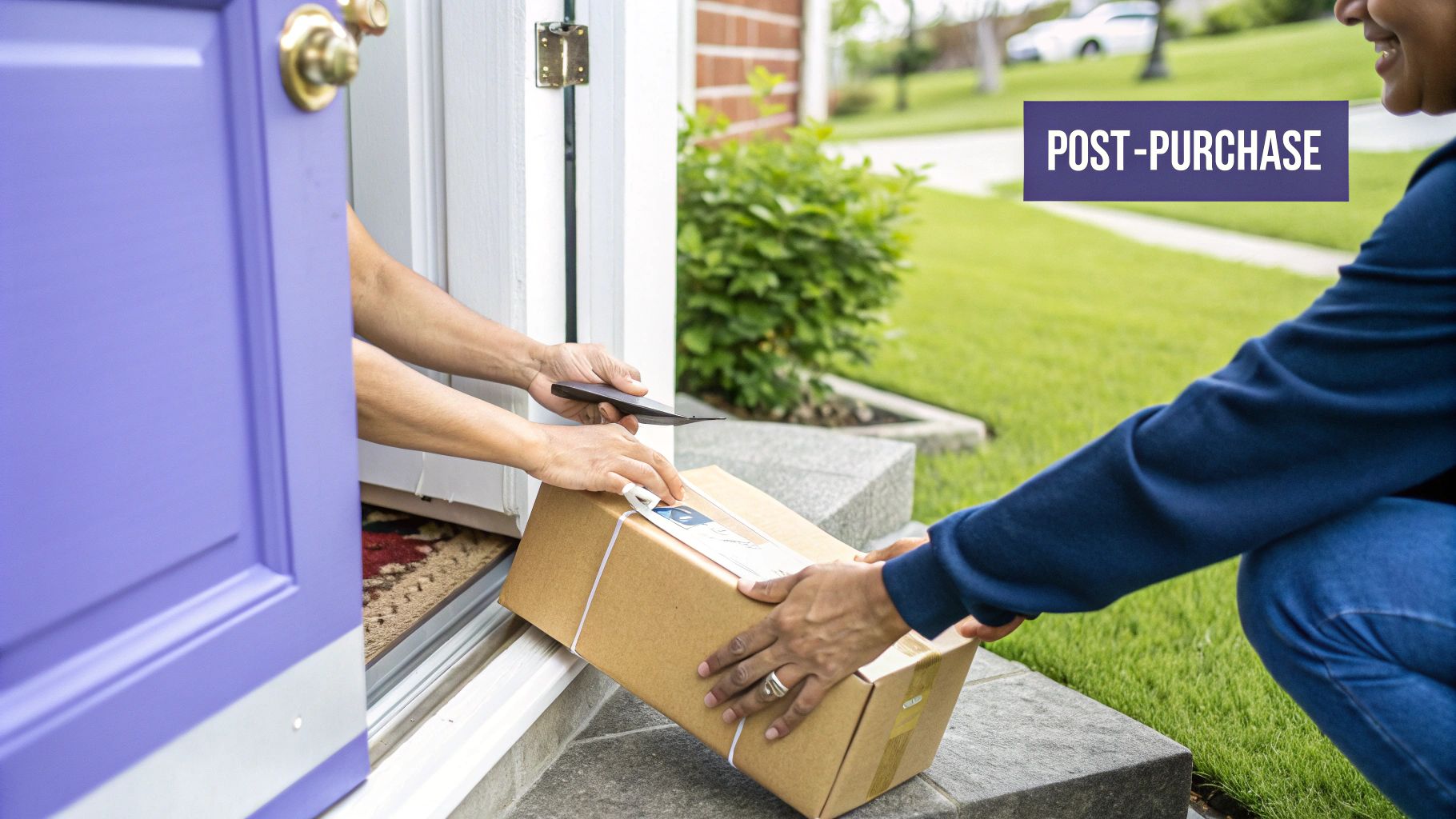
Why It's a Foundational Workflow
An automated event workflow is foundational for scaling lead generation and education efforts. It guarantees a consistent and professional experience for every registrant, from the moment they sign up until they become a qualified lead. This automation frees up your marketing team from manual, repetitive tasks like sending reminder emails or segmenting attendee lists, allowing them to focus on creating high-quality event content.
Beyond the specific email sequences, truly boosting your webinar/event marketing workflow involves leveraging comprehensive event management automation. This approach helps create a seamless experience that not only drives attendance but also provides valuable data for post-event segmentation and sales follow-up. It effectively turns a one-off event into a long-term lead-nurturing engine.
Actionable Takeaways
To build an effective webinar or event workflow, follow these key steps:
- Promote Strategically: Begin promoting your event 2-3 weeks in advance with multiple touchpoints across email and social media to maximize registrations.
- Automate Reminders: Send an immediate confirmation with a calendar file, followed by reminders one week, one day, and one hour before the event starts.
- Segment Your Follow-Up: Create two distinct follow-up paths. Send the event recording, slides, and extra resources to attendees. Send a "sorry we missed you" email with the recording to no-shows to re-engage them.
- Nurture Based on Engagement: Use data from the event, such as poll responses or questions asked, to place attendees into different nurture tracks. Highly engaged participants should be flagged for immediate sales outreach.
7. Birthday/Anniversary Workflow
A birthday or anniversary workflow is a highly personal, date-triggered automation that sends celebratory messages and offers to customers on significant dates. These milestones can include a customer's birthday, the anniversary of their first purchase, or the day they joined a loyalty program. This approach humanizes your brand, strengthens emotional connections, and drives impressive engagement.
The impact of this simple gesture is astonishing. Studies show birthday emails can generate 342% higher revenue per email compared to standard promotional messages. Their unique click rates are also 179% higher, proving that customers are highly receptive to personalized, celebratory communication. Brands like Sephora and Starbucks have mastered this. Sephora’s Beauty Insider program offers members a free gift during their birth month, while Starbucks Rewards members receive a complimentary birthday drink, creating powerful brand loyalty.
Why It's a Foundational Workflow
This workflow excels at customer retention by making individuals feel seen and valued beyond their transactional relationship with your brand. It’s a low-effort, high-reward strategy that leverages data you likely already have (or can easily collect) to create a moment of genuine delight. A well-timed, thoughtful message reinforces brand affinity and can reactivate dormant customers.
By celebrating personal milestones, you shift the conversation from purely promotional to relational. This builds long-term goodwill and encourages repeat business, making it an essential component of any customer lifecycle marketing strategy. It's a prime example of how marketing automation workflows can foster meaningful connections at scale.
Actionable Takeaways
To build an effective birthday or anniversary workflow, follow these key steps:
- Collect Dates Early: Add an optional "birth date" field to your signup or account creation forms. Frame it as a way for you to send them a special treat.
- Offer Genuine Value: Your offer should feel like a real gift, not just a repackaged discount. Think exclusive freebies, bonus loyalty points, or a higher-than-usual discount.
- Time it Strategically: Send the email at the beginning of the customer's birth month to give them ample time to redeem a month-long offer. For day-specific events, test sending the message the day before versus the day of the anniversary.
- Personalize the Message: Use a warm, celebratory tone. Keep the focus on the customer's special day rather than on making a hard sale. The offer should feel like an added bonus, not the primary focus.
8. Lead Magnet Delivery and Indoctrination Workflow
A lead magnet delivery and indoctrination workflow is a crucial automated sequence that kicks in when a user downloads a gated resource, like an ebook or checklist, in exchange for their contact details. This workflow does more than just deliver the promised asset; it begins a strategic indoctrination process designed to build trust, establish authority, and guide a cold lead toward becoming a customer.
The impact of this workflow is profound because it targets prospects at their moment of highest intent. They've just sought out your expertise. Digital marketing expert Neil Patel leverages this by delivering SEO guides instantly, then following up with tool recommendations and case studies. Similarly, HubSpot offers free templates and then nurtures leads with related blog content and webinar invites, seamlessly connecting the initial value proposition to their core product offering.
Why It's a Foundational Workflow
This workflow is your first real conversation with a potential customer, making it a foundational element for lead nurturing. It bridges the gap between a user simply wanting a free resource and understanding the broader value your brand provides. It sets the tone for all future communication and establishes your expertise on the topic of the lead magnet, making any subsequent sales pitch feel natural and earned rather than abrupt. To explore tools that can power this process, you can find a comprehensive guide on lead generation automation tools. This initial sequence is where you convert passive interest into active engagement.
This automation transforms a one-time content download into a structured, multi-touchpoint relationship, significantly increasing the likelihood of conversion down the line.
Actionable Takeaways
To build an effective lead magnet and indoctrination workflow, follow these key steps:
- Deliver Immediately: Send the lead magnet within seconds of the form submission. Any delay can cause frustration and diminish the user's initial excitement.
- Set Clear Expectations: In the first email, briefly explain what kind of valuable content they can expect to receive from you over the next few days. This reduces the chance of unsubscribes.
- Follow the 80/20 Rule: Structure your follow-up sequence to be 80% educational and value-driven, with only 20% dedicated to direct promotion. This builds trust before you ask for a sale.
- Stay Relevant: Ensure all follow-up content directly relates to the topic of the original lead magnet. If someone downloaded a "content marketing checklist," send them emails about content strategy, not paid ads.
Marketing Automation Workflow Comparison Table
| Workflow | Implementation Complexity 🔄 | Resource Requirements ⚡ | Expected Outcomes 📊 | Ideal Use Cases 💡 | Key Advantages ⭐ |
|---|---|---|---|---|---|
| Welcome Email Series Workflow | Moderate complexity with multi-channel triggers and personalization | Moderate: email content creation, automation setup | High open rates (50-86%), early conversions, strong engagement | New subscribers/customers onboarding | Builds trust, strong first impressions, drives early activation |
| Abandoned Cart Recovery Workflow | Moderate to high due to e-commerce integration and dynamic content | High: product data integration, multi-channel messaging | Recovers 10-30% lost sales, increases revenue | E-commerce stores targeting cart abandoners | High ROI, clear revenue impact, urgency-driven messaging |
| Lead Nurturing Drip Campaign | High complexity with behavior triggers, lead scoring, branching logic | High: extensive content creation, CRM integration | 50% more sales-ready leads, improved lead quality | B2B, complex sales cycles requiring education | Scales personalization, improves conversion rates |
| Re-engagement/Win-back Workflow | Moderate complexity with inactivity triggers and segmentation | Moderate: content updates, multi-channel approach | Re-engages 10-20% dormant subscribers, improves list health | Reactivating inactive customers/subscribers | Cost-effective retention, list hygiene improvement |
| Post-Purchase Follow-up Workflow | Moderate complexity, timing critical | Moderate: content strategy per product lifecycle | Increases customer lifetime value, encourages reviews | Recent customers post-purchase | Builds loyalty, reduces returns, drives repeat sales |
| Webinar/Event Marketing Workflow | High complexity with multi-stage automation and segmentation | High: coordination across teams and platforms | 30-50% higher attendance, quality lead generation | B2B lead generation, educational events | Automates event lifecycle, increases engagement |
| Birthday/Anniversary Workflow | Low complexity, date-trigger based | Low: setup once with minimal updates | 342% higher revenue per email, strong customer loyalty | Date-based customer milestones | High engagement, emotional connection, easy maintenance |
| Lead Magnet Delivery & Indoctrination Workflow | Moderate complexity with instant delivery and sequenced nurture | Moderate: gated content creation, sequenced emails | Captures leads and nurtures trust, improves conversions | Lead generation from gated content downloads | Immediate value delivery, segmented nurturing |
From Examples to Execution: Your Next Steps in Automation
We've journeyed through eight distinct yet interconnected marketing automation workflow examples, each a blueprint for creating more meaningful, timely, and effective communication. From the crucial first impression of a Welcome Email Series to the strategic resurrection of dormant customers with a Re-engagement Campaign, the common thread is clear: successful automation is deeply human-centric. It’s not about robotic, impersonal messaging; it’s about using technology to deliver the right message to the right person at the exact moment it matters most.
The workflows detailed, including Abandoned Cart Recovery, Lead Nurturing, and Post-Purchase Follow-ups, demonstrate a fundamental shift in marketing strategy. Instead of broad, one-size-fits-all campaigns, we move towards a model of personalized, trigger-based conversations that mirror the natural progression of a customer relationship. This is the core value proposition of automation: scaling intimacy and efficiency simultaneously.
Core Strategic Takeaways
The strategic DNA of these workflows isn't just in the sequence of emails or the timing delays. It's rooted in a deeper understanding of customer behavior and intent.
- Behavior as the Ultimate Trigger: Every powerful workflow we examined, from the webinar registration sequence to the abandoned cart series, is initiated by a specific user action. This action-based approach ensures your marketing is a relevant response, not an unwelcome interruption.
- Data is the Foundation: A workflow is only as intelligent as the data that powers it. Whether it's purchase history for a post-purchase upsell, engagement metrics for a win-back campaign, or key demographic data for a birthday offer, clean and accessible data is non-negotiable for personalization.
- Segmentation is Your Superpower: The difference between a generic drip campaign and a high-converting lead nurturing sequence lies in segmentation. By branching workflows based on user behavior (e.g., pages visited, content downloaded), you create hyper-relevant paths that guide prospects toward a solution, not just a sale.
Key Insight: Effective marketing automation isn't about replacing human marketers. It's about empowering them to focus on high-level strategy, creative problem-solving, and relationship-building by automating the repetitive, predictable tasks.
Your Actionable Roadmap to Automation Mastery
Moving from inspiration to implementation is the most critical step. Viewing these marketing automation workflow examples is insightful, but building your own is transformative. Here’s a simple, pragmatic plan to get started without getting overwhelmed.
- Identify Your Biggest Leak: Where is the most significant drop-off in your customer journey? Is it new leads going cold? A high cart abandonment rate? Low repeat purchase numbers? Pinpoint the one area where automation can have the most immediate financial or strategic impact.
- Map It Out Visually: Before you touch a single tool, grab a whiteboard or a digital canvas. Map out the ideal workflow for the problem you identified. What is the trigger? What is the first communication? What happens if they engage? What happens if they don't? This visual map is your architectural plan.
- Start with One Workflow: The temptation is to build everything at once. Resist it. Choose your highest-impact workflow, build it, test it, and launch it. Master one process, gather data, prove its value, and then move on to the next. This iterative approach builds momentum and internal buy-in.
- Measure, Analyze, Optimize: Automation is not a "set it and forget it" machine. Set clear KPIs for your workflow. Is it open rates, conversion rates, or customer lifetime value? Regularly review the performance and look for opportunities to A/B test subject lines, adjust timing, or refine segmentation logic.
For agencies, B2B service providers, and tech experts, the most powerful trigger isn't always on your website; it's an external buying signal. For example, a startup receiving a significant funding round is a prime indicator that they have capital to invest in growth, new hires, and technology. Automating outreach based on this trigger can put you in front of high-intent prospects before your competitors even know they exist. This is where strategic data becomes your ultimate competitive advantage, transforming your automation from reactive to truly proactive.
Ready to power your automation with the ultimate trigger event? Identifying newly funded startups is a game-changer for B2B outreach, and FundedIQ provides the hand-curated, verified data you need to act first. Integrate our real-time funding alerts directly into your CRM or outreach tool to trigger hyper-personalized workflows the moment a prospect has new capital to spend. Start connecting with decision-makers at the perfect time by visiting FundedIQ.



